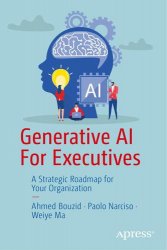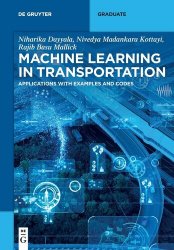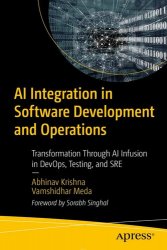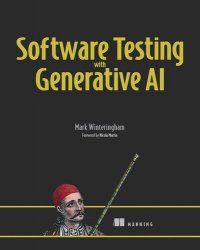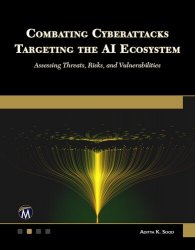 Название: Combating Cyberattacks Targeting the AI Ecosystem: Assessing Threats, Risks, and Vulnerabilities
Название: Combating Cyberattacks Targeting the AI Ecosystem: Assessing Threats, Risks, and VulnerabilitiesАвтор: Aditya K. Sood
Издательство: Mercury Learning and Information
Год: 2024
Страниц: 257
Язык: английский
Формат: epub (true)
Размер: 12.7 MB
This book explores in detail the AI-driven cyber threat landscape, including inherent AI threats and risks that exist in Large Language Models (LLMs), Generative AI applications, and the AI infrastructure. The book highlights hands-on technical approaches to detect security flaws in AI systems and applications utilizing the intelligence gathered from real-world case studies. Lastly, the book presents a very detailed discussion of the defense mechanisms and practical solutions to secure LLMs, GenAI applications, and the AI infrastructure. The chapters are structured with a granular framework, starting with AI concepts, followed by practical assessment techniques based on real-world intelligence, and concluding with required security defenses. Artificial Intelligence (AI) and cybersecurity are deeply intertwined and increasingly essential to modern digital defense strategies. The book is a comprehensive resource for IT professionals, business leaders, and cybersecurity experts for understanding and defending against AI-driven cyberattacks.
Artificial Intelligence (AI) and cybersecurity are deeply intertwined and increasingly essential to modern digital defense strategies. Organizations are adopting AI technology exponentially, resulting in a significant evolution of the cyber threat landscape. Adversaries are leveraging AI capabilities to enhance their tactics and techniques to launch scalable cyberattacks in an automated manner. The proliferation of AI-centric cyberattacks represents a significant evolution in the threat landscape, as adversaries increasingly leverage AI techniques to launch sophisticated and targeted attacks.
AI has emerged as a potent digital weapon in the arsenal of cyber attackers, fundamentally reshaping the landscape of cyber warfare. Leveraging AI algorithms, threat actors can automate and optimize various stages of cyber operations, from surveillance and infiltration to evasion and exfiltration. AI-powered malicious code can adapt its real-time behavior to evade detection by traditional security defenses. At the same time, AI-driven social engineering attacks can craft persuasive phishing messages tailored to specific individuals or organizations. AI-centric cyberattacks exploit vulnerabilities in AI systems, manipulate data, and evade traditional security defenses, posing new challenges for organizations worldwide. Additionally, the adversarial attacks targeting AI systems represent a sophisticated class of cyber threats where malicious actors deliberately manipulate AI models by introducing carefully crafted perturbations to input data. Adversaries employ AI to automate and scale their attacks, enabling them to adapt quickly to changing environments and evade detection by traditional security measures.
Features:
Includes real-world case studies with detailed examples of AI-centric attacks and defense mechanisms
Features hands-on security assessments with practical techniques for evaluating the security of AI systems
Demonstrates advanced defense strategies with proven methods to protect LLMs, GenAI applications, and the infrastructure
Technology, Tools, and Techniques You Need to Understand:
- Understanding of AI, ML, and Deep Learning principles. Familiarity with neural networks, supervised and unsupervised learning, and standard AI algorithms. Ability to identify and select key features from data sets for use in AI/ML models.
- Knowledge of basic cybersecurity principles, including confidentiality, integrity, and availability (CIA). Understanding of common threats and vulnerabilities, as well as basic defense mechanisms.
- Basic knowledge of programming languages commonly used in AI and cybersecurity, such as Python, Java, and C++. Experience with scripting languages like Bash or PowerShell for automating tasks.
- Familiarity with AI development tools such as TensorFlow, PyTorch, Keras, and Scikit-learn. Understanding how to build, train, and deploy AI/ML models using these frameworks.
- Experience with security tools like Wireshark for network analysis, Metasploit for penetration testing, nmap for scanning and other tools.
- Proficiency in concepts related to identify and respond to cybersecurity threats, including malware analysis, forensic investigation, and incident response. Familiarity with frameworks such as MITRE ATT&CK for understanding adversarial tactics and techniques.
- Skills in investigating and analyzing cyber incidents to determine their causes and effects.
Who Should Read This Book:
The AI cybersecurity book is not just a resource, but a powerful tool that empowers IT professionals, including system administrators, network engineers, and cybersecurity experts. These individuals, who are at the forefront of defending digital infrastructure, need to stay ahead of emerging threats that leverage AI. Understanding how AI can be both a tool for defense and a vector for sophisticated attacks will enable them to implement more robust security measures. This book provides them with the latest insights into AI-driven security technologies, threat detection methods, and response strategies, ensuring they can protect their organizations from advanced cyber threats and feel more confident in their roles.
Business leaders and executives also stand to gain significantly from this book. As decision-makers responsible for adopting and integrating AI technologies within their organizations, they must be aware of the potential security risks and the necessary safeguards to mitigate them. This knowledge is crucial for making informed decisions that balance innovation with security. Furthermore, students and academics in Computer Science, information technology, and cybersecurity will find the book invaluable for understanding the intersection of AI and security, preparing them to contribute effectively to this rapidly evolving domain. The book serves as a comprehensive guide, bridging the gap between technical detail and strategic insight, and fostering a sense of community among a broad audience committed to safeguarding the digital future.
Contents:
Скачать Combating Cyberattacks Targeting the AI Ecosystem: Assessing Threats, Risks, and Vulnerabilities
[related-news] [/related-news]
Комментарии 0
Комментариев пока нет. Стань первым!

